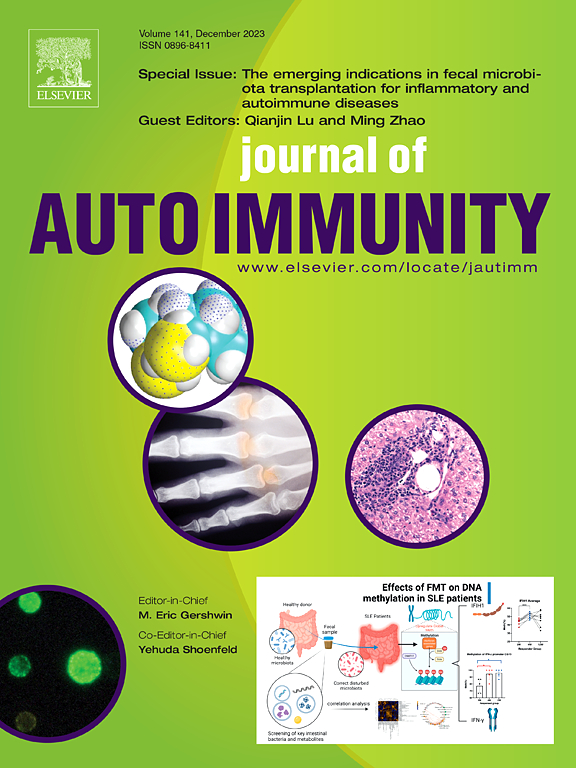EZH2 通过 METTL3 介导的 m6A 修饰促进原发性 Sjogren's 综合征的 B 细胞自身免疫。
IF 7
1区 医学
Q1 IMMUNOLOGY
引用次数: 0
摘要
目的泽斯特同源物增强子2(EZH2)在促进B细胞活化和分化方面发挥着重要作用。本研究旨在阐明EZH2在原发性斯约格伦综合征(pSS)B细胞自身免疫反应中的作用,并探索抑制EZH2对pSS的治疗潜力:方法:对 pSS 患者外周血中的 B 细胞进行单细胞 RNA 测序分析,以确定 B 细胞亚群中 EZH2 和 METTL3 的异常表达。在多个 B 细胞亚群和 pSS 患者唾液腺(SG)以及三种不同的斯约格伦综合征(SS)小鼠模型中进一步验证了 EZH2 的水平。研究人员进行了相关分析,以探讨 EZH2 的表达与 pSS 患者临床特征之间的关系。在实验性斯约格伦综合征(ESS)小鼠模型中,对抑制 EZH2 后的斯约格伦综合征样症状和抗体产生情况进行了评估。对EZH2抑制后的RNA测序(RNA-seq)和染色质免疫沉淀测序(ChIP-seq)数据进行了生物信息学分析,以确定EZH2在pSS中的靶点。通过 ChIP-qPCR 验证了 H3K27me3 与 CDKN1A 启动子的结合。流式细胞凋亡分析和羧基荧光素琥珀酰亚胺酯(CFSE)测定用于评估 EZH2 抑制剂对 B 细胞凋亡和增殖的影响。此外,还分析了 pSS 患者中 METTL3 的表达及其与疾病活动的相关性。在敲除 METTL3 后检测了 EZH2 的表达。进行了 METTL3-RNA 免疫沉淀(RIP)和放线菌素 D 检测,以确认 METTL3 与 EZH2 mRNA 的直接结合及其对 mRNA 稳定性的影响。进行了 M6A-RIP-qPCR 验证 EZH2 mRNA 上是否存在 m6A 修饰:结果:在 pSS 患者外周血和 SG 中的多个 B 细胞亚群以及三种不同的 SS 动物模型中发现 EZH2 上调。B 细胞中 EZH2 的表达与衡量疾病活动性的 ESSDAI 评分呈正相关。使用EZH2抑制剂治疗后,ESS小鼠的SS样症状减轻,自身抗体产生减少。同样,在 pSS 患者中,METTL3 在 SGs 和外周血 CD19+ B 细胞中的表达增加,也与 ESSDAI 评分呈正相关。随着 METTL3 的敲除,EZH2 的表达减少。从机理上讲,EZH2通过催化CDKN1A位点的H3K27me3修饰,抑制B细胞凋亡,促进B细胞增殖。此外,METTL3与EZH2 mRNA结合,增加了EZH2 mRNA上的m6A修饰,提高了其稳定性,促进了EZH2的表达:结论:METTL3介导的EZH2上调与pSS的B细胞自身免疫反应有关。抑制 EZH2 是一种治疗 pSS 的有效策略。本文章由计算机程序翻译,如有差异,请以英文原文为准。

EZH2 promotes B-cell autoimmunity in primary Sjogren's syndrome via METTL3-mediated m6A modification
Objective
Enhancer of zeste homologue 2 (EZH2) plays an important role in promoting B-cell activation and differentiation. This study aimed to elucidate the role of EZH2 in the B-cell autoimmune response in primary Sjögren's syndrome (pSS) and to explore the therapeutic potential of inhibiting EZH2 in pSS.
Methods
Single-cell RNA sequencing analysis of B cells in peripheral blood from pSS patients was conducted to identify abnormal expression of EZH2 and METTL3 in B-cell subsets. The levels of EZH2 were further validated across multiple B-cell subsets and the salivary glands (SGs) of pSS patients, as well as three different mouse models of Sjögren's syndrome (SS). Correlation analyses were performed to explore the relationship between the expression of EZH2 and clinical features of pSS patients. Following EZH2 inhibition, SS-like signs and antibody production were assessed in an experimental Sjögren syndrome (ESS) mouse model. RNA sequencing (RNA-seq) and chromatin immunoprecipitation sequencing (ChIP-seq) data post-EZH2 inhibition were bioinformatically analyzed to identify the EZH2 targets in pSS. ChIP-qPCR was performed to validate the binding of H3K27me3 to the CDKN1A promoter. Flow cytometric apoptosis analysis and Carboxy Fluorescein Succinimidyl Ester (CFSE) assay were used to assess the impact of an EZH2 inhibitor on B-cell apoptosis and proliferation. Additionally, METTL3 expression and its correlation with disease activity were analyzed in pSS patients. EZH2 expression was examined after METTL3 knockdown. METTL3-RNA immunoprecipitation (RIP) and actinomycin D assays were conducted to confirm the direct binding of METTL3 to EZH2 mRNA and its impact on mRNA stability. M6A-RIP-qPCR was performed to validate the presence of m6A modifications on EZH2 mRNA.
Results
EZH2 was found upregulated in multiple B-cell subsets from the peripheral blood and SGs of pSS patients, as well as in three different animal models of SS. The expression of EZH2 in B cells was positively correlated with the ESSDAI score, which is a measure of disease activity. With treatment of EZH2 inhibitor, SS-like signs alleviated and autoantibody production reduced in ESS mice. Similarly, in pSS patients, METTL3 expression was increased in the SGs and peripheral blood CD19+ B cells, also showing a positively correlated with the ESSDAI score. With knockdown of METTL3, the expression of EZH2 reduced. Mechanistically, EZH2 inhibited B-cell apoptosis and promoted B-cell proliferation by catalyzing H3K27me3 modification at the CDKN1A locus. Furthermore, METTL3 bound to EZH2 mRNA and increased m6A modification on EZH2 mRNA, enhancing its stability and promoting EZH2 expression.
Conclusions
The upregulation of EZH2 mediated by METTL3 is implicated in the B-cell autoimmune response in pSS. Inhibition of EZH2 presents a promising therapeutic strategy for pSS treatment.
求助全文
通过发布文献求助,成功后即可免费获取论文全文。
去求助
来源期刊

Journal of autoimmunity
医学-免疫学
CiteScore
27.90
自引率
1.60%
发文量
117
审稿时长
17 days
期刊介绍:
The Journal of Autoimmunity serves as the primary publication for research on various facets of autoimmunity. These include topics such as the mechanism of self-recognition, regulation of autoimmune responses, experimental autoimmune diseases, diagnostic tests for autoantibodies, as well as the epidemiology, pathophysiology, and treatment of autoimmune diseases. While the journal covers a wide range of subjects, it emphasizes papers exploring the genetic, molecular biology, and cellular aspects of the field.
The Journal of Translational Autoimmunity, on the other hand, is a subsidiary journal of the Journal of Autoimmunity. It focuses specifically on translating scientific discoveries in autoimmunity into clinical applications and practical solutions. By highlighting research that bridges the gap between basic science and clinical practice, the Journal of Translational Autoimmunity aims to advance the understanding and treatment of autoimmune diseases.
 求助内容:
求助内容: 应助结果提醒方式:
应助结果提醒方式:


